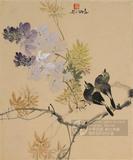宋代帝半身像 冊 宋神宗
推薦分享
資源連結
連結到原始資料 (您即將開啟新視窗離開本站)後設資料
- 資料識別:
- 中畫000322N000000007
- 資料類型:
- 類型:繪畫
- 型式:靜態圖像
- 主題與關鍵字:
- 帝王
- 出版者:
- 數位化執行單位:國立故宮博物院
- 格式:
- 本幅 55.8x46.9公分、對幅 55.8x46.9公分
- 關聯:
- 故宮書畫錄(卷七),第四冊,頁43-44&*1.劉芳如,〈無款宋神宗半身像〉,收入林柏亭主編,《大觀- 北宋書畫特展》(臺北:國立故宮博物院,2006年初版一刷),頁227- 228。 &*本幅收在〈宋代帝半身像〉冊第七開,清乾隆戊辰(1748)曾重新裝裱,四周覆以黃綾,對幅作楷書題記。 畫像中的神宗趙頊(1068-1085在位),蓄短髭,戴幞頭,身著朱袍,相貌堂堂。由於帝得年僅卅八,故畫像所見,亦尚年輕。趙頊自幼勤學,留心天下大事。二十歲即位後,即銳意革新,並啟用王安石,厲行變法。奈何遭到守舊派反彈,未幾,王氏被罷黜,神宗新政亦失卻揮灑的舞台。(20061206)&*This painting is the seventh leaf in the album “Half-length Portraits of Sung Dynasty Emperors”. It was remounted in 1748 during the Ch'ing dynasty, covered on four sides with yellow silk, and provided with an opposing leaf in regular script calligraphy. The subject of this portrait is Chao Hsü (r. 1068-1085), otherwise known as Emperor Shen-tsung. With a short moustache, he wears a black official's cap and a red gown, appearing quite stately in appearance. Since he passed away at the relatively early Chinese age of 38, he was still quite young when this portrait was done, as seen here. Chao Hsü was a diligent student since youth and paid close attention to major affairs of state as emperor. After he assumed the throne at the age of Chinese 20, he embarked on government reform with great determination, appointing Wang An-shih to enforce a new set of laws. However, he met resistance from the conservative faction at court. With his efforts stalled, Wang An-shih was ousted from office, and the new government policies of Shen-tsung lost their foothold and failed.(20061206)
- 管理權:
- 國立故宮博物院
授權聯絡窗口
- 國立故宮博物院圖像授權、出版授權、影音資料授權-申請流程說明
http://www.npm.gov.tw/zh-TW/Article.aspx?sNo=03003061






